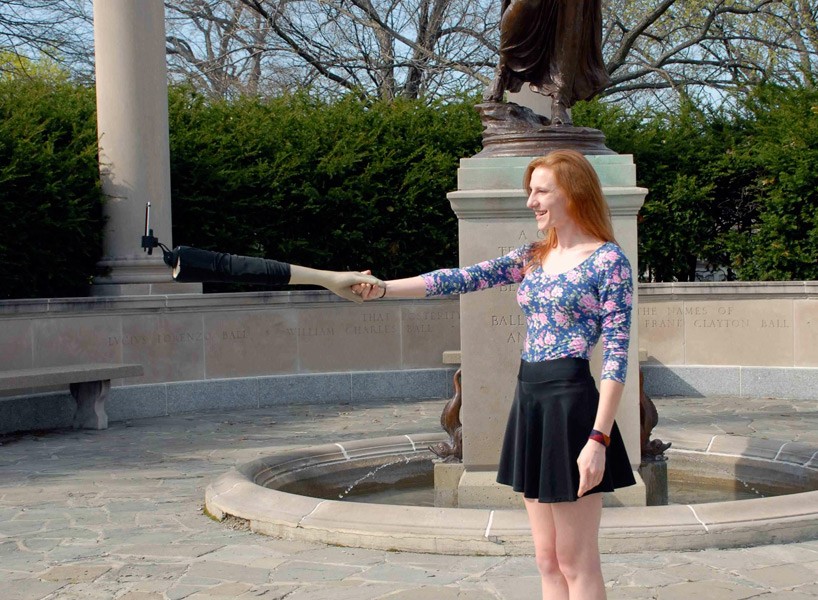The pursuit of all things self continues unabated in 2015. One has to wonder what children of the self-absorbed, selfie generations will be like. Or, perhaps, there will be no or few children, because many of the self-absorbed will remain, well, rather too self-absorbed.
From NYT:
Sometimes you don’t need an analyst’s report to get a look at the future of the media industry and the challenges it will bring.
On New Year’s Eve, I was one of the poor souls working in Times Square. By about 1 p.m., it was time to evacuate, and when I stepped into the cold that would assault the huddled, partying masses that night, a couple was getting ready to pose for a photo with the logo on The New York Times Building in the background. I love that I work at a place that people deem worthy of memorializing, and I often offer to help.
My assistance was not required. As I watched, the young couple mounted their phone on a collapsible pole, then extended it outward, the camera now able to capture the moment in wide-screen glory.
I’d seen the same phenomenon when I was touring the Colosseum in Rome last month. So many people were fighting for space to take selfies with their long sticks — what some have called the “Narcissistick” — that it looked like a reprise of the gladiatorial battles the place once hosted.
The urge to stare at oneself predates mirrors — you could imagine a Neanderthal fussing with his hair, his image reflected in a pool of water — but it has some pretty modern dimensions. In the forest of billboards in Times Square, the one with a camera that captures the people looking at the billboard always draws a big crowd.
Selfies are hardly new, but the incremental improvement in technology of putting a phone on a stick — a curiously analog fix that Time magazine listed as one of the best inventions of 2014 along with something called the “high-beta fusion reactor” — suggests that the séance with the self is only going to grow. (Selfie sticks are often used to shoot from above, which any self-respecting selfie auteur will tell you is the most flattering angle.)
There are now vast, automated networks to harvest all that narcissism, along with lots of personal data, creating extensive troves of user-generated content. The tendency to listen to the holy music of the self is reflected in the abundance of messaging and self-publishing services — Vine, WhatsApp, Snapchat, Instagram, Apple’s new voice messaging and the rest — all of which pose a profound challenge for media companies. Most media outfits are in the business of one-to-many, creating single pieces of text, images or audio meant to be shared by the masses.
But most sharing does not involve traditional media companies. Consumers are increasingly glued to their Facebook feeds as a source of information about not just their friends but the broader world as well. And with the explosive growth of Snapchat, the fastest-growing social app of the last year, much of the sharing that takes place involves one-to-one images that come and go in 10 seconds or less. Getting a media message — a television show, a magazine, a website, not to mention the ads that pay for most of it — into the intimate space between consumers and a torrent of information about themselves is only going to be more difficult.
I’ve been around since before there was a consumer Internet, but my frame of reference is as neither a Luddite nor a curmudgeon. I didn’t end up with over half a million followers on social media — Twitter and Facebookcombined — by posting only about broadband regulations and cable deals. (Not all self-flattering portraits are rendered in photos. You see what I did there, right?) The enhanced ability to communicate and share in the current age has many tangible benefits.
My wife travels a great deal, sometimes to conflicted regions, and WhatsApp’s global reach gives us a stable way of staying in touch. Over the holidays, our family shared endless photos, emoticons and inside jokes in group messages that were very much a part of Christmas. Not that long ago, we might have spent the time gathered around watching “Elf,” but this year, we were brought together by the here and now, the familiar, the intimate and personal. We didn’t need a traditional media company to help us create a shared experience.
Many younger consumers have become mini-media companies themselves, madly distributing their own content on Vine, Instagram, YouTube and Snapchat. It’s tough to get their attention on media created for the masses when they are so busy producing their own. And while the addiction to self is not restricted to millennials — boomers bow to no one in terms of narcissism — there are now easy-to-use platforms that amplify that self-reflecting impulse.
While legacy media companies still make products meant to be studied and savored over varying lengths of time — the movie “Boyhood,” The Atlantic magazine, the novel “The Goldfinch” — much of the content that individuals produce is ephemeral. Whatever bit of content is in front of someone — text messages, Facebook posts, tweets — is quickly replaced by more and different. For Snapchat, the fact that photos and videos disappear almost immediately is not a flaw, it’s a feature. Users can send content into the world with little fear of creating a trail of digital breadcrumbs that advertisers, parents or potential employers could follow. Warhol’s 15 minutes of fame has been replaced by less than 15 seconds on Snapchat.
Facebook, which is a weave of news encompassing both the self and the world, has become, for many, a de facto operating system on the web. And many of the people who aren’t busy on Facebook are up for grabs on the web but locked up on various messaging apps. What used to be called the audience is disappearing into apps, messaging and user-generated content. Media companies in search of significant traffic have to find a way into that stream.
“The majority of time that people are spending online is on Facebook,” said Anthony De Rosa, editor in chief of Circa, a mobile news start-up. “You have to find a way to break through or tap into all that narcissism. We are way too into ourselves.”
Read the entire article here.


